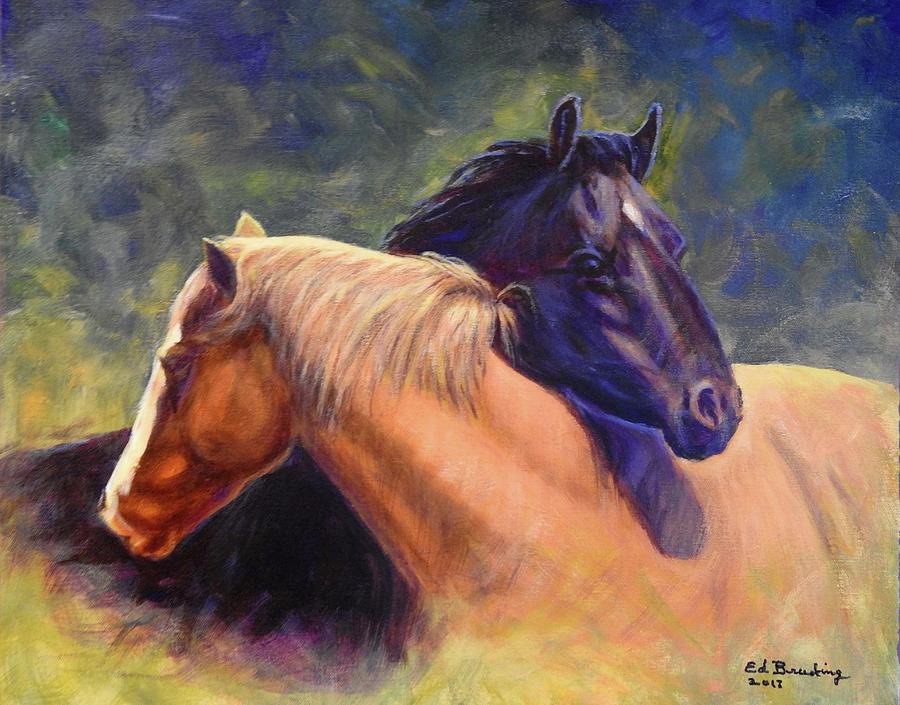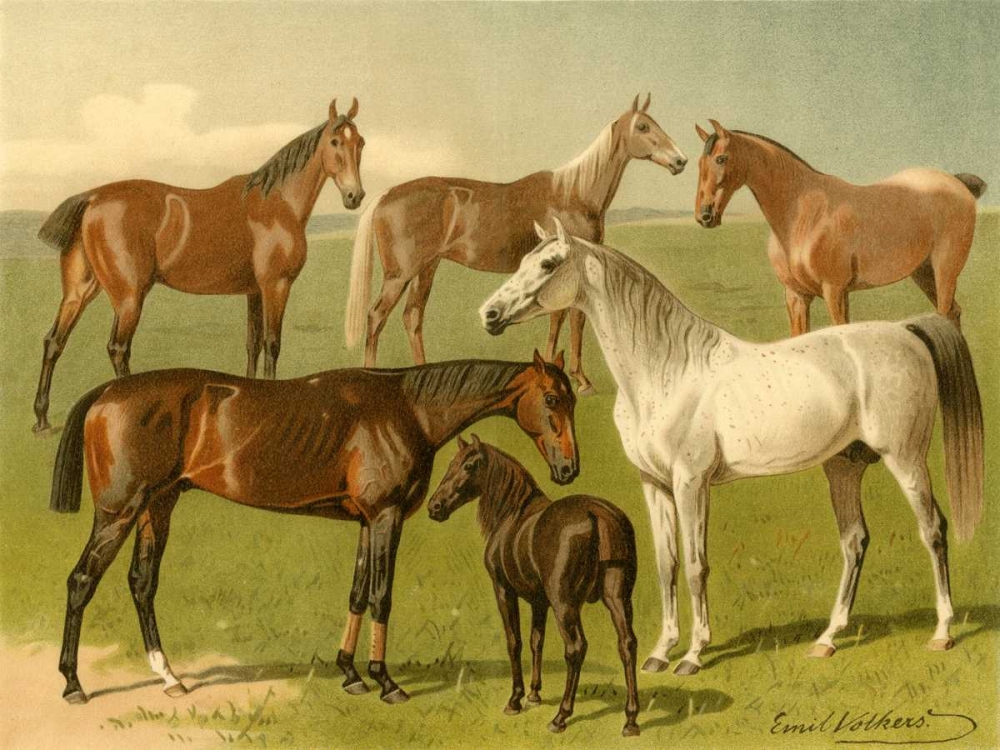Horse Breeding (sage ability)
Horse breeding is an expert-status sage ability that enables skill in the selective breeding of horses. The study involves techniques for enhancing desired traits in domesticated horses through controlled reproduction. It also grants expertise in managing healthy pregnancies and ensuring successful foaling.
The character can recognise a horse's pedigree upon examination, assessing conformation, lineage, temperament and overall health to determine suitability for breeding. This knowledge allows for careful selection of mating pairs, ensuring that desirable traits such as speed, endurance, strength or temperament are preserved and refined. Beyond choosing strong bloodlines, the character understands how diet, environment and conditioning influence fertility and foal development, increasing the likelihood of producing superior offspring.
Pedigree
For game purposes, a simplified method is used to determine the pedigree of horses. Each horse is evaluated based on health, robustness, speed, courage and fertility. These characteristics define the animal's quality and suitability for specific roles. Health measures resistance to disease and fatigue; robustness determines strength and endurance as a working animal; speed reflects value as a racehorse; courage assesses temperament in combat situations; and fertility influences breeding success and the likelihood of positive mutations.
All horses, whether wild or domesticated, already possess specific characteristics relating to their type, shaped by generations of breeding. Each breed has been refined with particular traits in mind — workhorses prioritise robustness and health, while warhorses are selected for courage and, to a lesser extent, speed. A horse's pedigree is assessed within the context of its breed rather than compared universally across all horses.
Rolling Characteristics
Each characteristic is determined by rolling 4d6, producing an average of 14. These numbers are relative to the breed rather than an absolute measure — meaning a warhorse with a speed of 14 is not as fast as a racehorse with a speed of 14. Instead, these values represent the horse's standing within its own breed, adjusting its capabilities accordingly.
Each point above or below 14 results in a 1% adjustment to that characteristic within the breed standard.
- For example, a pony with a health of 12 would be 2% less resistant to disease than a pony with a health of 14. A pony with robustness of 16 could carry 2% more encumbrance. A pony with speed 16 would be 2% faster; one with courage 16 would have 2% improved morale; and one with fertility 16 would be 2% more likely to reproduce and pass on favourable traits.
While these adjustments may seem small, they have significant effects when applied across generations. Over time, selective breeding allows minor improvements to accumulate, leading to better racehorses, hardier workhorses or stronger warhorses. This is the same process by which early wild horses, lean and agile, were eventually bred into the massive, strong-boned warhorses of later centuries.
Mating
The formula provides a broad distribution of potential offspring, allowing for unique and valuable horses that may command higher prices or develop deep personal significance to their owners. Breeding is managed simply in game terms, as it is assumed that a horse breeder fully understands each horse's pedigree as outlined above. The stallion and mare are selected, and the offspring randomly inherits the pedigree of one parent or the other for each characteristic.
A mutation roll on a percentile die determines if the offspring experiences an improvement. If a mutation occurs, the highest two pedigree characteristics of the offspring increase by 1–2 points. If more than two characteristics share the highest value, a random roll determines which two are raised.
If "00" is rolled, the mutation is negative. In this case, two random pedigree characteristics, regardless of their importance, are each reduced by 1 point.
To maintain strong bloodlines, careful selection of mates is necessary. Second cousins increase the likelihood of a negative mutation to 10%, first cousins to 20%, and mating between siblings or direct ancestors raises the risk to 40%. Under normal conditions, horses instinctively avoid mating with close relatives, particularly siblings and direct ancestors.
For example, a male stallion with 18 health, 15 robustness, 9 speed, 10 courage and 16 fertility is mated with a female mare whose corresponding characteristics are 16h, 10r, 10s, 16c and 18f. A 50% roll is made for each characteristic to determine which parent's trait is dominant in the offspring. In this case, the dominant traits come from the female, male, male, female and female, resulting in an offspring with 16h, 15r, 9s, 16c and 18f. By chance, this offspring is markedly better than both parents.
The total mutation chance is determined by the combined fertility of the parents, with each parent contributing 1% per 4 points of fertility. The male provides a 2% chance (from 16 fertility), while the female adds 4% (from 18 fertility), resulting in a 6% mutation chance. If a mutation occurs, the offspring's fertility is improved by 1–2 points, and one additional characteristic — either health or courage (determined by a 50% roll) — is similarly increased. If a negative mutation is rolled (00 on percentile dice), two random characteristics each decrease by 1 point.
The lower likelihood of negative mutations reflects centuries of selective breeding, where inferior horses have been steadily culled from the breeding pool. In this setting, magic has further refined the process, ensuring that beneficial traits are reinforced more reliably than in human history. Pedigree scores above 24 are possible through continued careful breeding, allowing for the gradual development of superior horses over time.
Purchasing
Only characters with Horse Breeding ability can recognise the exact characteristics of a given horse upon examination. However, even unskilled characters can discern when horseflesh is noticeably superior or inferior when comparing animals from different markets.
When purchasing a horse, the number and quality of available animals depend on the size of the market. Small markets with 1 point of reference only offer "average" horses, where each pedigree characteristic is rolled on 4d6 with no modifications. In larger markets, horses tend to be of better stock; for each point above market-1, ½ point is added to the average pedigree. Thus, a market-7 offers horses with an average pedigree of 17 rather than 14.
Since horses can be examined before purchase, a horse breeder is able to recognise the pedigree numbers for each animal. This examination takes about 10 seconds per horse when assessing health, robustness or fertility below 12, as these flaws are outwardly visible. More detailed evaluation of other characteristics requires 5 minutes per horse. If many horses are available, the DM may opt to reroll any pedigree characteristic of 11 or lower for visible traits and allow the breeder to inspect the remaining animals as long as desired.
- For example, a horse breeder is choosing among five horses in a small market. Instead of rolling for all traits immediately, only the three visible characteristics are checked first. The first horse rolls a 10 for health, which is immediately dismissed as too low. The second horse rolls a 16 in health but only a 9 in robustness, making it undesirable as well. This method streamlines the selection process, avoiding unnecessary rolls for unqualified animals.
A horse breeder can negotiate a lower price if the total pedigree score of a horse is below 70 points. The adjusted price is determined by dividing the horse's total pedigree by 70 and applying that percentage to the listed cost.
The best horses are withheld from standard sale and offered at auction. These animals are still available for examination, but their final purchase price is subject to competitive bidding, often exceeding normal market rates.
Bloodlines
Numerous horse breeds already exist, with standardised pedigrees established over time. No formal list of horse breeds has been created yet, though this should eventually be addressed to provide reference for different lineages and their characteristics.
Through consistent breeding over multiple generations — where stallions and mares share interchangeable pedigrees — characters may develop a unique or semi-unique bloodline. In such cases, it would be reasonable to establish specific coat colours and distinctive markings to define the emerging breed. This process can be handled as needed, with players having input, as they would play a direct role in shaping the bloodline's traits and reputation.

